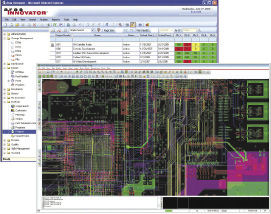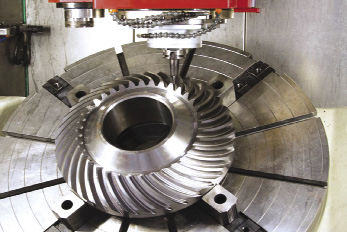PLM Tackles Complex Industrial Machine Design
Amid pressure to innovate, industrial machine manufacturers are turning to product lifecycle management to reduce design complexity and facilitate time-to-market.
December 4, 2001
By Beth Stackpole
Whether we’re talking the much-hyped Boeing 787 jetliner or the latest luxury roadster from BMW, product lifecycle management (PLM) has had a starring role in nearly every major product rollout in the automotive and aerospace sectors for the better part of a decade. Yet PLM has only been a bit player in the effort to engineer industrial machinery—a scenario experts say is changing thanks to a greater emphasis on software and configurable systems.
 PTC Windchill 10.2 allows manufacturing engineers to visually construct process plans. Image courtesy of PTC. |
Defined as those plant floor robotic arms, automated conveyors, and packaging systems that hum along to produce everything from the latest in electronics gear to food and beverage items, industrial equipment has blossomed into a $400 billion-plus global industry that shows little sign of slowing down. The machines are complex products involving thousands of subassemblies and a mix of electronic, mechanical and software components. While offered in base configurations, most industrial equipment is highly customized to meet specific requirements. And with multimillion-dollar price tags, the machinery constitutes a major capital expense, which assures it a lengthy lifetime of work in the field.
If you’ve noticed the similarities between industrial equipment design and that of aircraft and other complex systems, you’d be right on target. With these similarities come comparable design challenges for manufacturers in this space, including the pressure to innovate, keep quality and performance standards high, deal with complex bill of material (BOM) structures, and deliver a high level of support from installation all the way through the entirety of a product’s lifecycle.
It’s been well documented that PLM, with its promise of a one-version-of-the-truth repository for all things product related, has vastly helped aerospace and automotive companies manage much of the complexity related to product development—all while pushing the boundaries of innovation. Industrial equipment companies have been slower on the PLM adoption curve, experts say, in part because they lack the budgets of larger aerospace and automotive giants. But it’s also because many are still immersed in the traditional engineering culture of functional silos and over-the-wall, iterative development cycles.
Even that has started to change, with companies in the industrial machinery space coming face-to-face with demand for increasingly smarter and highly configurable products.
“Companies in this sector have reached an inflection point, where they need to look at their engineering processes and determine how to manage the entire process in a manner that’s not as disconnected as it today,” explains Rahul Garg, senior director, machinery industry for Siemens PLM Software. “They have the mechanical design tools in place—and maybe even the CAD data management tools—but they can now leverage the business value that PLM can provide them.”
 With Aras Innovator, companies can manage MCAD, ECAD and PCB data in the same system. Image courtesy of Aras. |
CIMdata, a consultancy that keeps a finger on the pulse on the PLM market, is already seeing signs that the process is becoming entrenched in the industrial equipment sector. In its most recent annual market analysis, the research company estimated that global spending on collaborative product definition management (what it dubs cPDM and a core component of PLM) in the industrial machinery segment exceeded $1.5 billion in 2010. It’s forecasted to grow at an 11% compounded annual growth rate over the next five years.
Software-driven Design Complexity
PLM is finally taking off in this market for a variety of reasons, but by far the biggest one is increasing design complexity, according to Stan Przybylinski, CIMdata’s vice president of research. PLM has evolved to help manufacturers deal with much of the complexity beyond pure CAD data management—for example, managing requirements across the functional areas of mechanical, electrical and software, and integrating ECAD and software data as part of a broader, systems engineering-oriented design process.
“Software has grown in importance, but the ability to support the development ]of the software systems] and integrate with the other elements of the product is complicated,” Przybylinski says. “The tools are really only just now emerging to help people model some of this interaction.”
Most of the major PLM vendors have taken steps to address the mechatronics aspects of product design, adding new modules and capabilities for managing the software and electrical components of an engineering effort. PTC, for example, in 2011 acquired MKS, the maker of the Integrity suite of requirements management, software configuration management, and application lifecycle management software. The acquisition and subsequent integration of Integrity and Windchill PLM have resulted in the Systems Requirements and Validation solutions, notes Tom Shoemaker, PTC’s vice president of PLM marketing. These deliver traceability across all the functional domains involved in product development, including so-called “smarter” industrial machines that are more reliant on controls, sensors and software to drive their intelligence and automation.
 Aras PLM helps Breton handle the complexity around designing custom-configured equipment, including this system used to machine metal and stone. Image courtesy of Breton S.p.a. |
“With the need to be ‘smart’ comes increased complexity of systems, whether it’s material handling or robotics,” Shoemaker says. “That means engineers now have to make sure that the mechanical design efforts stay in lockstep with the electrical design, which stays in lockstep with the software design effort, and the whole thing is treated as a collective system.”
This notion of systems engineering is certainly nothing new. While leaders in the automotive and aerospace sectors are continually talking up the practice, industrial machine companies have been in the trenches with systems engineering for some time, notes Paul Brown, senior marketing director for Siemens PLM Software.
 Breton’s industrial machines are use to cut and mill stone, including granite kitchen countertops. Image courtesy of Breton S.p.a. |
“Auto and aerospace companies talk about systems engineering, but in machinery, they’ve been doing systems engineering and no one talks about it,” Brown says.
To address the systems engineering requirements of the industrial machinery and other industry sectors, Siemens has released Mechatronics Concept Designer, a platform for machine design. It allows users to trace customer requirements all the way through to a finished design, and enables mechanical, electrical and automation functions to develop and collaborate in parallel.
Thomas Strigl, Ph.D., is helping his clients adopt Mechatronics Concept Designer to connect all the various constituents involved into the design process with one tool. He’s CEO of ISILOG, which works with industrial machine companies on production planning.
“It doesn’t mean the electrical or automation guys need to work inside of NX or Mechatronics Concept designer, but they can get access to the detailed design to use for testing and developing the right automation,” Strigl explains.
The big advantage to this is working as an integrated team, Strigl says. For example, if an additional sensor was required, the mechanical designers could make the hole required to house the sensor in the same design, without having to import and export data or prepare models for testing.
The Configuration Challenge
While software is raising the bar on design complexity, so is the need for custom configuration. Most industrial equipment manufacturers build special-purpose machines that are highly configured for specific plant environments. Rather than start each product design from scratch, companies in this space are striving to create an internal catalog of standard parts modules, which can then be reused and reconfigured to meet an individual customer’s specification, explains Peter Schroer, president of PLM maker Aras.
“They try to have a standard catalog, but what they are really shipping out the back door is different every time,” he explains. Without a full PLM system to manage the product data, there can be real problems when years later, a customer wants a second, identical machine, but the design has changed or there are new suppliers for key parts. “The customer doesn’t want something new; they want something exactly the same because it’s predictable,” Schroer says. “It’s a very difficult problem for most PDM systems to solve.”
Aras PLM has been architected with complex processes and BOMs in mind, Schroer says. The system employs technology for building a BOM by customer order, aiding in custom configuration, and Aras is invested in adding more application lifecycle management functionality to the PLM platform to address the rising software requirements, he says.
Claudio Saurin, product development director at Breton S.p.a., an Italian company that manufactures industrial equipment for machining stone, says his company has been able to streamline its design processes, removing waste and shrinking development cycles, via its use of Aras PLM. Previously, the company used a collection of systems to manage the product data, which was far less efficient, he explains.
“We would have a set of documentation comprised of drawings stored in a PDM system, documents in a file system, email in an email system, and our BOM data stored in SAP so the system was not holistic,” Saurin says. “It was a very demanding effort.”
While PLM technology provides the platform on which to integrate all the design data, it’s really more about process change and getting engineers to adapt to cross-functional integrated workflows. Today, most mechanical engineers are using CAD to model what’s relevant to their part of the project, but they need to change their mindset to do work that could be useful to the electrical engineering department or the software group and vice versa, Strigl says. So, for example, if they’re modeling an axis, they should be looking at the kinematics definition of the machine.
“That’s not often done by the mechanical team, and that’s the challenge,” Strigl concludes. “It means reorganizing processes and taking on a bit more.”
Beth Stackpole is a contributing editor to DE. You can reach her at [email protected].
More Info
Subscribe to our FREE magazine, FREE email newsletters or both!
About the Author
Beth Stackpole is a contributing editor to Digital Engineering. Send e-mail about this article to [email protected].
Follow DE





